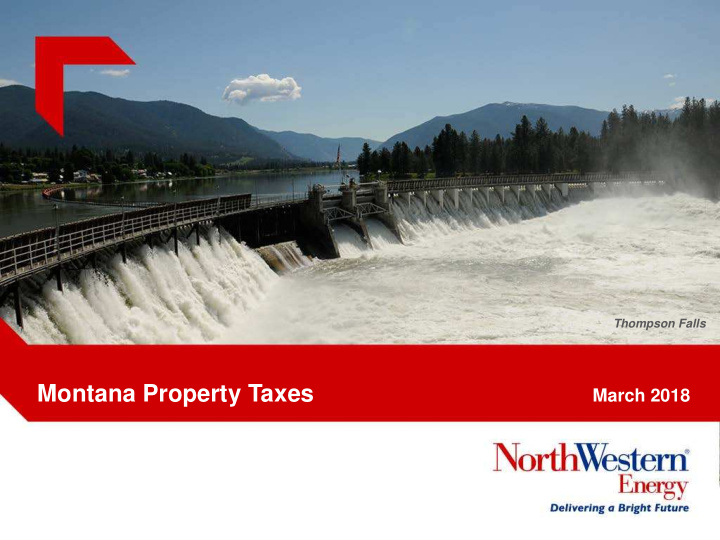



Thompson Falls Montana Property Taxes March 2018
Montana Operating Expenses Total Expense increased on average of 6.2% per year since 2010. Increase of O&M, A&G (Controllable) Expenses was 3.3% Our controllable expenses (O&M and A&G) as a percentage of total expenses have gone from 56% concentration in 2010 down to 46% in 2017. 2
Largest Property Taxpayer in Montana NWE is the largest tax payer in Montana, paying nearly 36% of all centrally assessed property taxes. 3
Largest Property Taxpayer in many counties Reflects diversity of our investments NWE paid over $150 million in Montana property taxes in 2017, with over $86 million or 57% of all taxes coming from 6 counties (Cascade, Missoula, Gallatin, Yellowstone, Lewis & Clark and Butte-Silver Bow. 4
Montana Property Taxes Growing unsustainably NorthWestern Energy’s property taxes in Montana as compared to the labor and benefits we pay our Montana employees have gone from 0.7 times in 2010 to 1.2 times in 2017. Our MT property taxes as a percentage to total Operating, Administrative and General (OA&G) expenses has gone from 28% in 2010 to 37% in 2017. 5
Montana Property Tax Perspective Both NorthWestern Energy’s property taxes in Montana on a per customer basis and also as a percentage of Montana Operating Revenues have increased by an average of 8.2% since 2010. While NWE’s utility bills are below the national average, the high percentage of property taxes is a primary driver of why our utility bills are higher than the regional average. 6
Montana Property Tax Perspective In Montana, our Property Taxes as a percentage of Operating Revenues is 16.6% based on 2017 property tax expenses (purple bar). Montana’s 16.6% ratio is 2.9 times the peer average of 5.7% and 2.0 times the next closest peer – Great Plains Energy (GXP) at 8.5%. 7
NWE Working to Keep Customer Bills Low Since 2005, through negotiations and when necessary protests (’05, ‘06, & ‘07) and appeals, NWE has reduced property tax expense in Montana by nearly $108 million ($8.3 million average per year) from the Department $108 million savings to MT customers of Revenue’s through negotiations or protests original assessment . 8
NWE Incentivized to Keep MT Property Taxes Low Since 2005, $108 million savings to MT customers through negotiations and through negotiations or protests when necessary, protests (‘05, ‘06, & ‘07) and appeals, we have saved Montana customers nearly $108 million in property taxes. Our 2018 expected shareholder burden will be approximately $15 million of property taxes. 9
Make-up of a Typical Residential Bill Fixed Costs Recovered Through Variable Rates Variable Supply Costs - fuel (coal/natural gas) to produce the energy. This cost varies throughout the day largely depending on demand Residential Service Charge – administrative fixed fee Property Taxes – Montana Centrally Assessed Property Taxes Generation (fixed costs) - production of energy for our customers– in general, 81.4% are fixed costs includes fixed cost of physical assets, maintenance, and repairs Distribution Services - deliveries energy to homes/businesses – in general, includes fixed cost of physical assets, maintenance, and repairs Transmission System - deliveries energy across our territory – in general, includes fixed cost of physical assets, maintenance, and repairs Providing utility service is capital intensive. Most costs do not increase or decrease based on customers’ volumetric usage. NWE recovers costs through “spinning meters,” compared to electric co-ops that rely more on recovery through higher fixed monthly charges. NorthWestern Energy typical monthly Montana residential rates 10 for 750 kWh per month as of 10/1/2017
Fixed Costs Recovered Through Variable Charges Typical NWE Residential Electric Bill in MT Providing utility service is 2.2 cents or 18.6% capital intensive. Most of the bill costs do not increase or is variable decrease based on supply customers’ volumetric costs usage. 9.6 cents NWE recovers costs or 81.4% through “spinning of the bill meters,” compared to is fixed costs electric co-ops that rely more on recovery through higher fixed monthly charges. 11 NorthWestern Energy typical Montana residential rates as of 10/1/2017
Lower Cost of Capital Benefits Customers Cost of Capital = 21.9% of bill Cost of capital (Debt cost and Equity return) makes up 21.9% of a typical residential bill. Keeping our cost of capital and other costs as low as possible helps keep bills lower than the national average. 12
Recommend
More recommend